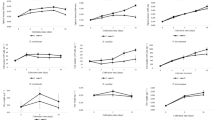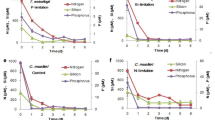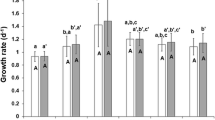Abstract
Nannochloropsis sp. was grown with different levels of nitrate, phosphate, salinity and temperature with CO2 at 2,800 μl l−1. Increased levels of NaNO3 and KH2PO4 raised protein and polyunsaturated fatty acids (PUFAs) contents but decreased carbohydrate, total lipid and total fatty acids (TFA) contents. Nannochloropsis sp. grew well at salinities from 22 to 49 g l−1, and lowering salinity enhanced TFA and PUFAs contents. TFA contents increased with the increasing temperature but PUFAs contents decreased. The highest eicosapentaenoic acid (EPA, 20:5ω3) content based on the dry mass was above 3% under low N (150 μM NaNO3) or high N (3000 μM NaNO3) condition. Excessive nitrate, low salinity and temperature are thus favorable factors for improving EPA yields in Nannochloropsis sp.
Similar content being viewed by others
References
Al-Hasan RH, Ali AM, Ka’wash HH, Radwan SS (1990) Effect of salinity on the lipid and fatty acid composition of the halophyte Navicula sp.: potential in mariculture. J Appl Phycol 2:215–222
Bligh EG, Dyer WJ (1959) A rapid method of total lipid extraction and purification. Can J Biochem Physiol 37:911–917
Chini Zittelli G, Lavista F, Bastianini A, Rodolfi L, Vincenzini M, Tredici MR (1999) Production of eicosapentaenoic acid by Nannochloropsis sp. cultures in outdoor tubular photobioreactors. J Biotech 70:299–312
Harrison PJ, Thompson PA, Calderwood GS (1990) Effects of nutrient and light limitation on the biochemical composition of phytoplankton. J Appl Phycol 2:45–56
Harrison PJ, Waters RE, Taylor FJR (1980) A broad spectrum artificial seawater medium for coastal and open ocean phytoplankton. J Phycol 16:28–35
Hoshida H, Ohira T, Minematsu A, Akada R, Nishizawa Y (2005) Accumulation of eicosapentaenoic acid in Nannochloropsis sp. in response to elevated CO2 concentrations. J Appl Phycol 17:29–34
Hu H, Gao K (2003) Optimization of growth and fatty acid composition of a unicellular marine picoplankton, Nannochloropsis sp., with enriched carbon sources. Biotech Lett 25:421–425
James CM, Al-Hinty S, Salman AE (1989) Growth and ω3 fatty acid and amino acid composition of microalgae under different temperature regimes. Aquaculture 77:337–351
Kochert G (1978) Carbohydrate determination by the phenol–sulfuric acid method. In: Hellebust JA, Craigie JS (eds) Handbook of phycological methods: physiological and biochemical methods. Cambridge University Press, Cambridge, pp 95–97
Lee Y-K, Tan H-M, Low C-S (1989) Effect of salinity of medium on cellular fatty acid composition of marine alga Porphyridium cruentum (Rhodophyceae). J Appl Phycol 1:19–23
Renaud SM, Parry DL (1994) Microalgae for use in tropical aquaculture II: effect of salinity on growth, gross chemical composition and fatty acid composition of three species of marine microalgae. J Appl Phycol 6:347–356
Renaud SM, Zhou HC, Parry DL, Thinh L-V, Woo KC (1995) Effect of temperature on the growth, total lipid content and fatty acid composition of recently isolated tropical microalgae Isochrysis sp., Nitzschia closterium, Nitzschia paleacea, and commercial species Isochrysis sp. (clone T.ISO). J Appl Phycol 7:595–602
Shifrin NS, Chisholm SW (1981) Phytoplankton lipids: interspecific differences and effects of nitrate, silicate and light-dark cycles. J Phycol 17:374–384
Sukenik A (1999) Production of eicosapentaenoic acid by the marine eustigmatophyte Nannochloropsis. In: Cohen Z (ed) Chemicals from microalgae. Taylor & Francis, London pp 41–56
Uriarte I, Farías A, Hawkins AJS, Bayne BL (1993) Cell characteristics and biochemical composition of Dunaliella primolecta Butcher conditioned at different concentrations of dissolved nitrogen. J Appl Phycol 5:447–453
Xu N, Zhang X, Fan X, Han L, Zeng C (2001) Effects of nitrogen source and concentration on growth rate and fatty acid composition of Ellipsoidion sp. (Eustigmatophyta). J Appl Phycol 13:463–469
Zhu CJ, Lee YK, Chao TM (1997) Effect of temperature and growth phase on lipid and biochemical composition of Isochrysis galbana TK1. J Appl Phycol 9:451–457
Acknowledgements
This study was funded by the National Natural Science Foundation of China (No. 90411018 and No. 30270036) and by the Chinese Academy of Sciences. The authors are grateful to Professor Ruixiang Li for providing the species.
Author information
Authors and Affiliations
Corresponding author
Rights and permissions
About this article
Cite this article
Hu, H., Gao, K. Response of Growth and Fatty Acid Compositions of Nannochloropsis sp. to Environmental Factors Under Elevated CO2 Concentration. Biotechnol Lett 28, 987–992 (2006). https://doi.org/10.1007/s10529-006-9026-6
Received:
Accepted:
Published:
Issue Date:
DOI: https://doi.org/10.1007/s10529-006-9026-6




